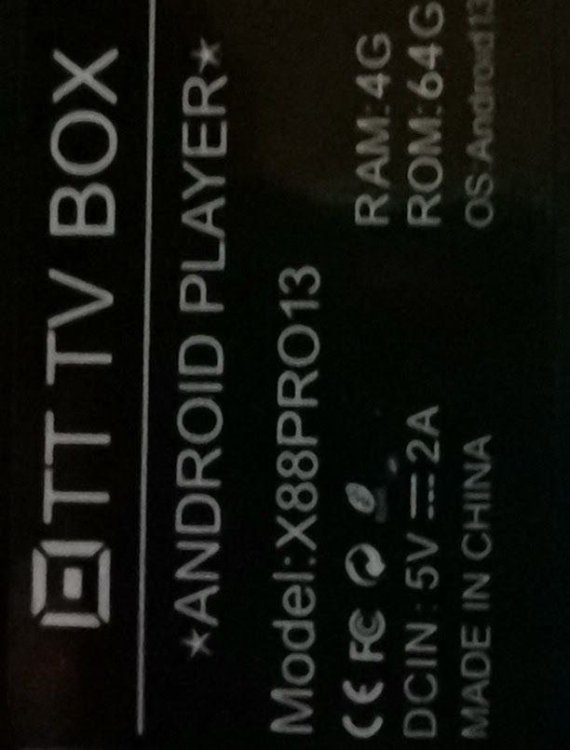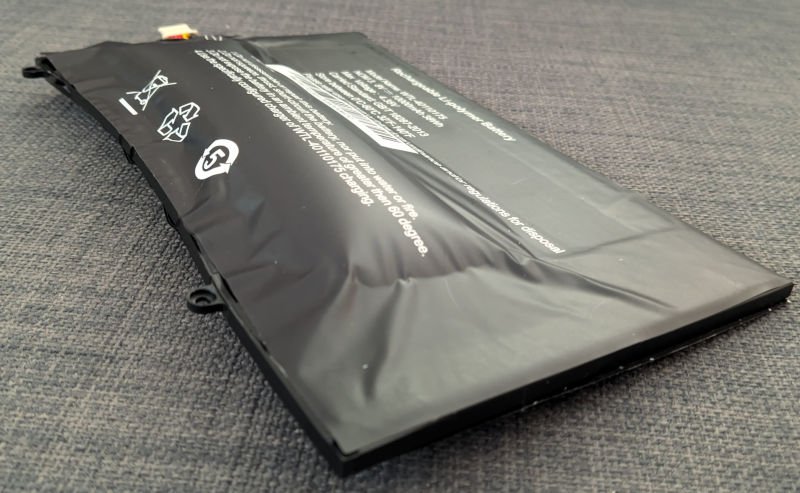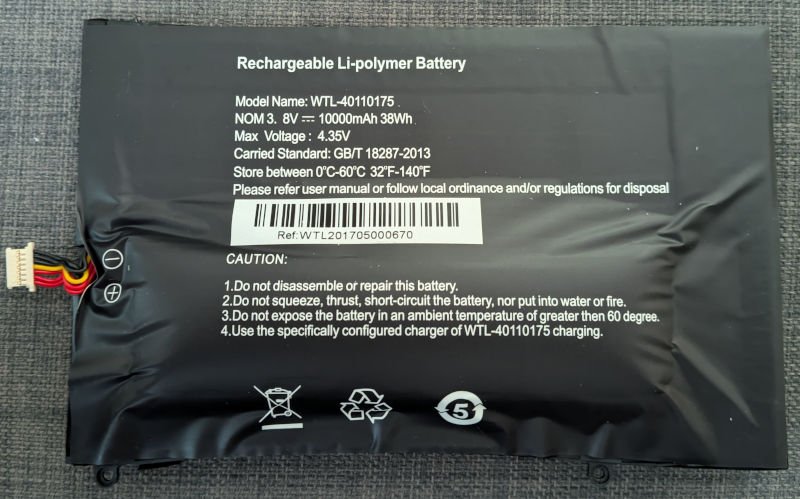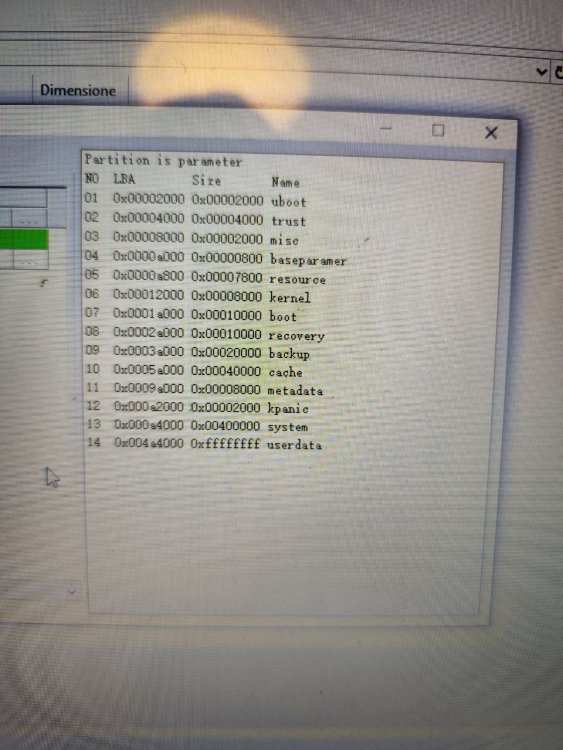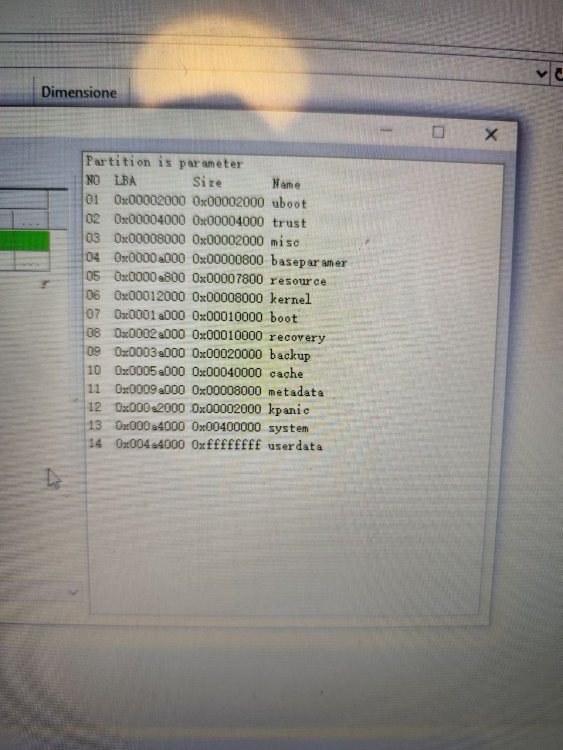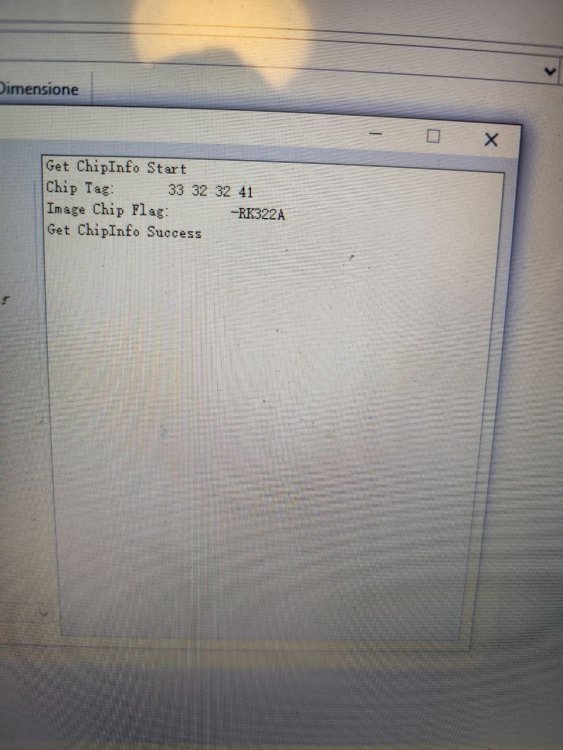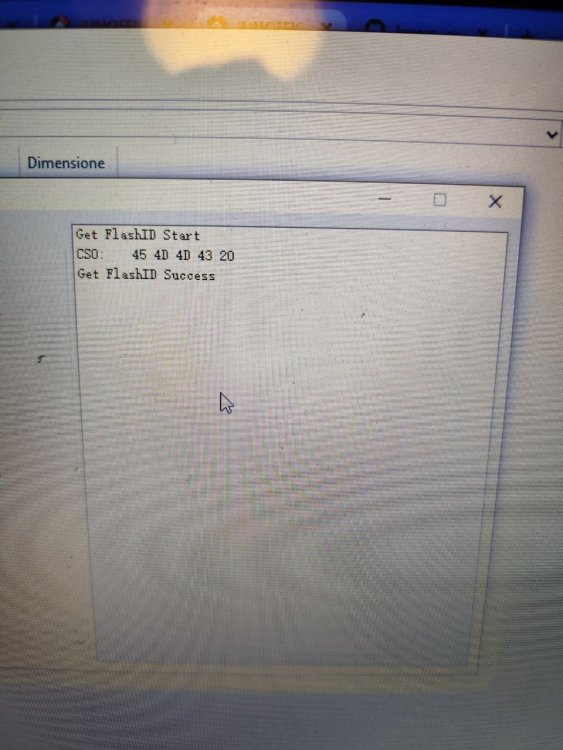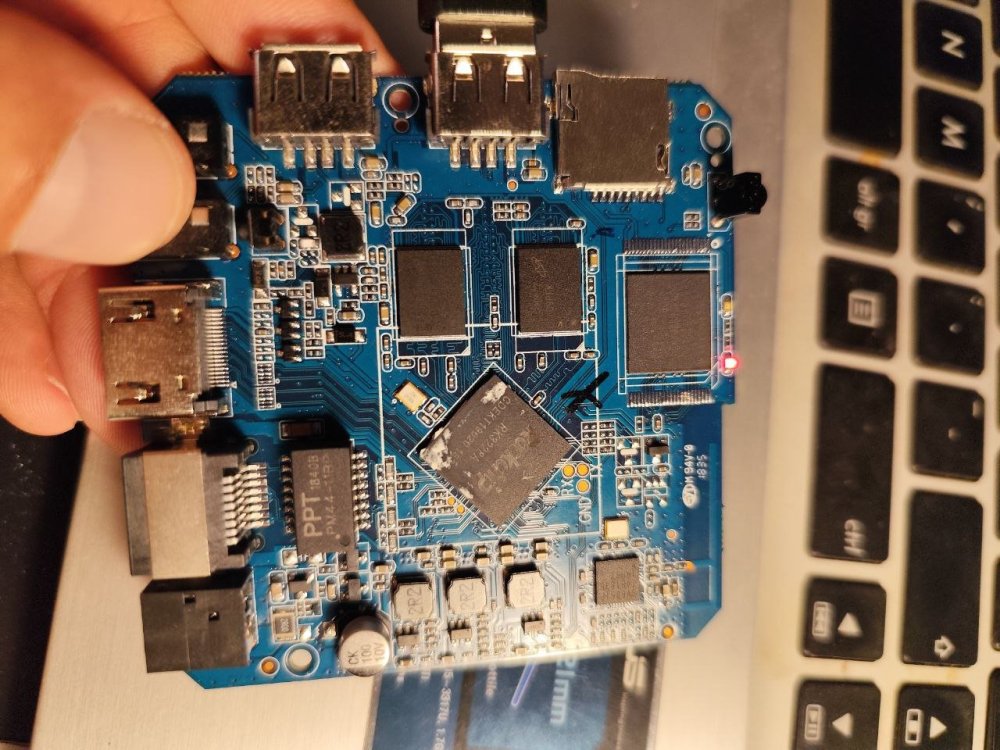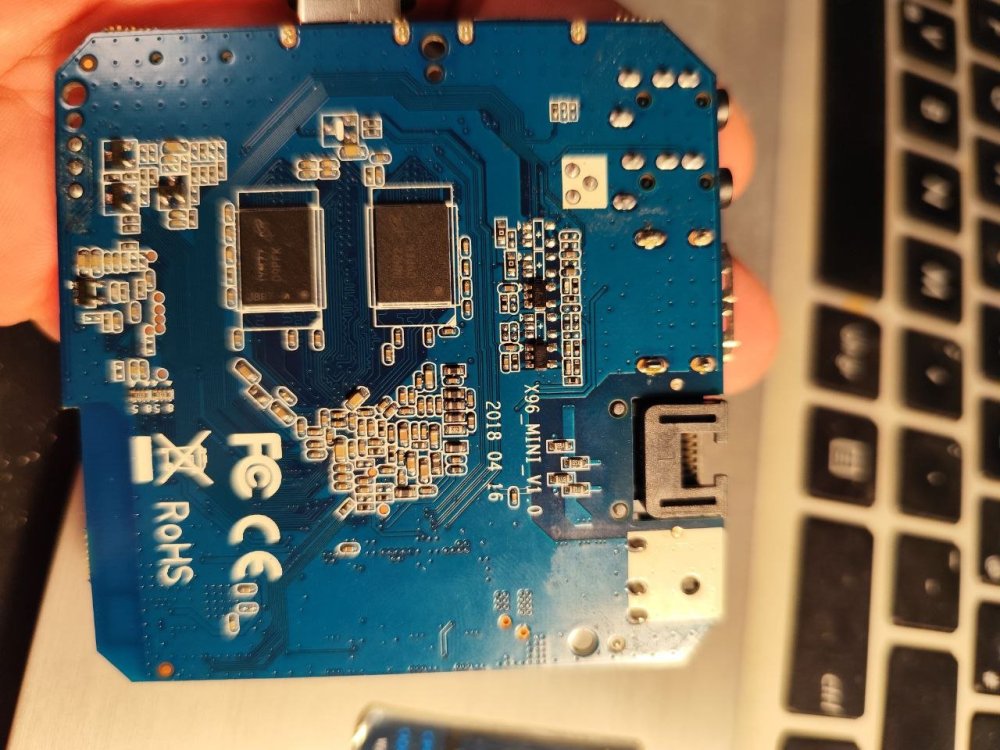Active threads
Showing topics posted in for the last 365 days.
- Past hour
-
@eli It's compiled in the kernel https://github.com/NickAlilovic/build/blob/Radxa-A7A/config/kernel/linux-sun60i-legacy.config#L1659-L1672
- Today
-
I gave some information ..... Hit:8 http://fi.mirror.armbian.de/beta bookworm InRelease ? 🙂
-

Setup for current Armbian/Ubuntu (25.8.2) for PCF8563 RTC on C2
Scott Ksander replied to Scott Ksander's topic in Odroid C2
I tried rebuilding the Device Tree as suggested in other forums. No Joy!! Still can't get it to work. Also added i2c-dev module but that isn't showing in lsmod. Help appreciated. Clearly I am missing something here. This shouldn't be difficult. :-) -
Apparently, there are more versions of the box. One has two stars on the nameplate and "V 1.4" printed on the PCB. Although WiFi works on version 1.2, if does not work on this version V1.4 has a different Wi-Fi chip: EA6521. dmesg | grep 'SDIO' gives: [ 9.621165] mmc2: new ultra high speed SDR104 SDIO card at address 8800
-
> drop them. > drop it. sorry. Someone is dropping something here I'm not sure if support was ever better or downgraded at one point because it never had it's own page on the site, it's just a mention of a device tree file swap under orange pi 5, which is listed as standard. If it's not different enough to warrant it's own page, it's entirely reasonable to think it is supported as much as the orange pi 5, under which it can be found. The max, plus and pro variants all have their own pages. 🤷♂️ I do understand how tooling works, as I've spend enormous amounts of time digging through the repo and modifying it. Mix and matching patches, modules, or loaders from other projects where their stuff works , and armbian's doesnt or visa versa, to get full functionality images across for the 6 different sbcs I've got. Often times certain projects will have things like vpu figured out way before other projects.
-
@emor acid The build system downloads the original uboot and kernel sources. Then it applies the patches on top. Whatever you edited will be erased. The only way around this is to create a patch with your changes. You could use dtc to compile your dts file into a binary dtb. Then copy it into your sdcard.
-
Yesterday I did start to install armbian trixie iot on my Pinebook. Second part in debian - after the u-boot) starts, but then the Pinebook shuts off, because of a low battery(?) I did charge the whole day and powered off in the evening. Today the Pinebook stand on my table with a swollen battery. I removed it and happily it doesnt crash anything else than the battery holder. But now it doenst boot up complete like with a low battery. After the u-boot debian trixie does boot , but at the middle of the messages it does shutdown Can it run completly without battery? I have normally a 5V/2Ah power-supply connected and that did work the last years. Now I can only try to use a 5V/60W quick-charge Power-Supply. Anyone has experiences with that? Thanks for info in advance...
-

Vontar KK MAX / HK1 RBOX R2 / R3 - RK3566 4GB/32GB(or 64GB)
Deoptim replied to Deoptim's topic in Rockchip CPU Boxes
Continuing the story. Or 4pda (Russian). -
If you have patience, CEC may work at some point with mainline kernel. There is not fast solution.
-

Update issue armbian-bsp-cli-rpi4b-current held back
callegar replied to binkerd's topic in Raspberry Pi
See There is an issue with the build framework that prevents base-files from being built for the arm64 target. At present time the issue is unresolved, and the root cause might be still unknown. - Yesterday
-

Anyone have Armbian 24.11 image for Jetson Nano?
Igor replied to ArmOnJetson's topic in Other families
https://github.com/armbian/os/commits/25.11.0-trunk.367/git_sources.json This file determine state (hash) of sources. It's not a straightforward process, but one can recreate exact image (except userspace packages, which versions are not stored) This file has to be here https://github.com/armbian/build/commit/31e82512cc60a74f56b710aa2971d7dc2beec9b9 One day, this will be done better Sadly there is too much of such e-waste and way way too little people willing to maintain them in their limited private time. I am sure you can find a working image somewhere in our archives so you don't need to throw it away, but we cannot fool you & ourselves to be able to keep this board maintained. -

Cannot run ARMbian on my tv box (TX10 PRO)
Farhan Ishraq replied to erebus041's topic in Allwinner CPU Boxes
@erebus041 @Nick AOne small detail: I've used etchdroid and drofus to burn my sd card. -

noble server and xfce fail to start up properly on RPi5
c0rnelius replied to Janos Szigetvari's topic in Raspberry Pi
Ok. Also I think these are wrong for the PI5: dtoverlay=disable-wifi dtoverlay=disable-bt I believe it's: dtoverlay=disable-wifi-pi5 dtoverlay=disable-bt-pi5 My notes on this: # Pi3 / ZERO2W dtoverlay=pi3-disable-wifi dtoverlay=pi3-disable-bt # PI5 dtoverlay=disable-wifi-pi5 dtoverlay=disable-bt-pi5 # Everything else dtoverlay=disable-wifi dtoverlay=disable-bt Back in the day, I read somewhere that Bluetooth can inhibit serial from functioning correctly on the Pi's. I've never seen it happen, but maybe using the wrong overlay is hindering it in some way? Worth looking into. -
I just noticed from your screenshot that you aren't using Armbian. You need to ask support questions for non-armbian software from where you got your software. Ophub is a fork of Armbian that used the Armbian name without permission. They do not contribute to Armbian development nor do they contribute the these forums.
-

Gaming experience with Orange Pi 5 (RK3588) on Armbian
heyrict replied to KhanhDTP's topic in Orange Pi 5
Armbian Trixie XFCE (Edge kernel 6.18.0-rc3-edge-rockchip64) + Stable mesa 25.0.7-2 + box64-rk3588 0.3.9+20251106.dcd3ba0-1 (https://ryanfortner.github.io/box64-debs/) + wine-10.18-staging-tkg-amd64-wow64 (https://github.com/Kron4ek/Wine-Builds/releases) + dxvk-sarek v1.11.0-sarek-async-writeaccessfix-malifix-5d21d2b (https://github.com/pythonlover02/DXVK-Sarek/actions) Elin ~40fps@720p -
Hip hip hooray !!! Yep, this way worked. Will provide the all steps for people who have the same issue. $ apt install linux-u-boot-rock-5b-edge $ armbian-install # Just in case I've installed to the all partitions. I mean to 5th and 7th. > 5 Install/Update the bootloader on SD card (/dev/mmcblk1) > 7 Install/Update the bootloader on MTD Flash $ reboot And now I can enter to uboot shell change to F2: 1068MHz ch0 ttot12 ch1 ttot12 ch2 ttot12 ch3 ttot12 change to F3: 1560MHz ch0 ttot14 ch1 ttot14 ch2 ttot14 ch3 ttot14 change to F0: 2112MHz ch0 ttot16 ch1 ttot16 ch2 ttot16 ch3 ttot16 out U-Boot SPL 2024.04-armbian-2024.04-S830c-P0000-Hd72c-Vdfa5-Bb703-R448a (Oct 24 2025 - 02:33:30 +0000) Trying to boot from SPI ## Checking hash(es) for config config-1 ... OK ## Checking hash(es) for Image atf-1 ... sha256+ OK ## Checking hash(es) for Image u-boot ... sha256+ OK ## Checking hash(es) for Image fdt-1 ... sha256+ OK ## Checking hash(es) for Image atf-2 ... sha256+ OK ## Checking hash(es) for Image atf-3 ... sha256+ OK INFO: Preloader serial: 2 NOTICE: BL31: v2.3():v2.3-868-g040d2de11:derrick.huang, fwver: v1.48 NOTICE: BL31: Built : 15:02:44, Dec 19 2024 INFO: spec: 0x1 INFO: code: 0x88 INFO: ext 32k is not valid INFO: ddr: stride-en 4CH INFO: GICv3 without legacy support detected. INFO: ARM GICv3 driver initialized in EL3 INFO: valid_cpu_msk=0xff bcore0_rst = 0x0, bcore1_rst = 0x0 INFO: l3 cache partition cfg-0 INFO: system boots from cpu-hwid-0 INFO: disable memory repair INFO: idle_st=0x21fff, pd_st=0x11fff9, repair_st=0xfff70001 INFO: dfs DDR fsp_params[0].freq_mhz= 2112MHz INFO: dfs DDR fsp_params[1].freq_mhz= 528MHz INFO: dfs DDR fsp_params[2].freq_mhz= 1068MHz INFO: dfs DDR fsp_params[3].freq_mhz= 1560MHz INFO: BL31: Initialising Exception Handling Framework INFO: BL31: Initializing runtime services WARNING: No OPTEE provided by BL2 boot loader, Booting device without OPTEE initialization. SMC`s destined for OPTEE will return SMC_UNK ERROR: Error initializing runtime service opteed_fast INFO: BL31: Preparing for EL3 exit to normal world INFO: Entry point address = 0xa00000 INFO: SPSR = 0x3c9 ns16550_serial serial@feb50000: pinctrl_select_state_full: uclass_get_device_by_phandle_id: err=-19 U-Boot 2024.04-armbian-2024.04-S830c-P0000-Hd72c-Vdfa5-Bb703-R448a (Oct 24 2025 - 02:33:30 +0000) Model: Radxa ROCK 5 Model B DRAM: 16 GiB Core: 353 devices, 32 uclasses, devicetree: separate MMC: mmc@fe2c0000: 1, mmc@fe2d0000: 2, mmc@fe2e0000: 0 Loading Environment from SPIFlash... SF: Detected xt25f128 with page size 256 Bytes, erase size 4 KiB, total 16 MiB *** Warning - bad CRC, using default environment In: serial@feb50000 Out: serial@feb50000 Err: serial@feb50000 Model: Radxa ROCK 5 Model B rockchip_dnl_key_pressed: no saradc device found Net: No ethernet found. Hit any key to stop autoboot: 0 => Great Thanks a lot
-
Hi I'm looking to emulate an industrial device such as eWon or ESA router by using an sbc with dual eth and tailscale/headscale. What is the best and cheapest board? better if with a decent chassis. I'm interested in something like nanopi Rx or orangepi Rx. Any idea? thank you
-
I see from https://github.com/nextcloud/nextcloudpi/releases that 'pi' is sort of a synonymy for 'ARM SBC' or pre-installed images. 'pi' is great but a problem as it is not generic arm64 so every SBC flavor needs a 1GByte zip image just for a different kernel and bootloader. Same as long time ago I used a 'pi' script to get Node-RED installed in an x86 Debian Bullseye Virtual Machine (so just 'Debian' actually), I would focus on generic solutions. Armbian is doing very well w.r.t. alignment and portability, so the SoC or SBC does not really matter, as long as it is compliant with Debian ARM64. For Node-RED on Opensuse-Tumbleweed ARM64 I needed to hack the script a bit to fake a compliance check, but with that, it also worked. It saved an enormous amount of effort re-installing OS etc. So bottom line is, maker sure you don't lock yourself into a certain SBC or SoC, but make sure it is standard generic ARM64 (or standard x86-64, which is already the case for years) A way to keep your current installation is to 'virtualize' it: What runs on the Odroid or RaspberryPi or other SBC from SD-card or eMMC or NVME or SSD can be made EFI bootable and then it will run as virtual machine on the same SBC or other new/faster SBC of course as well. I have done this for RPI3B functions -> RPI4B in the past (also 32-bit VM in 64-bit host, Pi-Hole for example) and this year again to replace RPi4B-8GB with ROCK5B-16GB. It is beyond the scope of this topic, but start with installing 'virt-manager' and try to boot and Armbian-UEFI image/instance. Or see: https://github.com/nextcloud/vm I haven't used 'cloud' since owncloud, but right now, if I would certainly start with a VM. Same for e.g. HAOS, runs fine in a VM on ROCK5B. You do not need proxmox, all is build-in in Linux already.
-
Building a new image did not solve the issue. no output on lsusb when plugging in anything. no output related to usb on dmesg. I personally think it is related to missing dts information. I did find this: https://github.com/armbian/linux-rockchip/blob/rk-6.1-rkr5.1/arch/arm/configs/rk3506-usb-otg.config And this: https://github.com/armbian/linux-rockchip/blob/rk-6.1-rkr5.1/arch/arm/configs/rk3506-usb-host.config Which I hope will enable me to use the usb. Specifcially: CONFIG_USB_COMMON=y & CONFIG_USB_GADGET=y & CONFIG_USB=y Will see what I can do after work today since it is friday Also for my own information, Here is the dtsi for the rk3506: https://github.com/armbian/linux-rockchip/blob/rk-6.1-rkr5.1/arch/arm/boot/dts/rk3506.dtsi And also this one: https://github.com/armbian/linux-rockchip/blob/rk-6.1-rkr5.1/arch/arm/boot/dts/rk3506b-luckfox-lyra-zero-w-sd.dts
-

Support for TC358743 CSI to HDMI on Radxa Zero 3W
opi-5-plus-user posted a topic in Radxa Zero 3W/3E
I have tried to get the CSI port working on my Radxa Zero 3W with the GEEKOM X1301 HAT, and now I can get the chip to show up in /dev, however there seems to be an issue when I try to access it, as I keep getting ioctl errors. I started by copying over the .dtbo files from the regular radxa official image, and putting them into the overlay-user folder in /boot. Then I enabled the radxa-zero3-tc358743.dtbo overlay, which gets the devices to show up. I am following this guide from GEEKOM https://wiki.geekworm.com/X1300_Software, however, I keep getting ioctl errors when trying to set the EDID file on the Radxa Zero. On the Raspberry Pi, this was not an issue. Here is the output of my media-ctl: media-ctl -d /dev/media0 -p Media controller API version 6.1.115 Media device information ------------------------ driver rkisp-vir0 model rkisp0 serial bus info platform:rkisp-vir0 hw revision 0x0 driver version 6.1.115 Device topology - entity 1: rkisp-isp-subdev (4 pads, 8 links, 0 routes) type V4L2 subdev subtype Unknown flags 0 device node name /dev/v4l-subdev0 pad0: SINK,MUST_CONNECT [stream:0 fmt:UYVY8_2X8/640x480 field:none colorspace:srgb crop.bounds:(0,0)/640x480 crop:(0,0)/640x480] <- "rkisp-csi-subdev":1 [ENABLED] <- "rkisp_rawrd0_m":0 [] <- "rkisp_rawrd2_s":0 [] pad1: SINK <- "rkisp-input-params":0 [ENABLED] pad2: SOURCE [stream:0 fmt:YUYV8_2X8/640x480 field:none colorspace:smpte170m quantization:full-range crop.bounds:(0,0)/640x480 crop:(0,0)/640x480] -> "rkisp_mainpath":0 [ENABLED] -> "rkisp_selfpath":0 [ENABLED] -> "rkisp_iqtool":0 [ENABLED] pad3: SOURCE -> "rkisp-statistics":0 [ENABLED] - entity 6: rkisp-csi-subdev (6 pads, 5 links, 0 routes) type V4L2 subdev subtype Unknown flags 0 device node name /dev/v4l-subdev1 pad0: SINK,MUST_CONNECT [stream:0 fmt:UYVY8_2X8/640x480 field:none colorspace:srgb] <- "rockchip-csi2-dphy0":1 [ENABLED] pad1: SOURCE,MUST_CONNECT [stream:0 fmt:UYVY8_2X8/640x480 field:none colorspace:srgb] -> "rkisp-isp-subdev":0 [ENABLED] pad2: SOURCE -> "rkisp_rawwr0":0 [ENABLED] pad3: SOURCE pad4: SOURCE -> "rkisp_rawwr2":0 [ENABLED] pad5: SOURCE -> "rkisp_rawwr3":0 [ENABLED] - entity 13: rkisp_mainpath (1 pad, 1 link) type Node subtype V4L flags 0 device node name /dev/video0 pad0: SINK <- "rkisp-isp-subdev":2 [ENABLED] - entity 19: rkisp_selfpath (1 pad, 1 link) type Node subtype V4L flags 0 device node name /dev/video1 pad0: SINK <- "rkisp-isp-subdev":2 [ENABLED] - entity 25: rkisp_rawwr0 (1 pad, 1 link) type Node subtype V4L flags 0 device node name /dev/video2 pad0: SINK <- "rkisp-csi-subdev":2 [ENABLED] - entity 31: rkisp_rawwr2 (1 pad, 1 link) type Node subtype V4L flags 0 device node name /dev/video3 pad0: SINK <- "rkisp-csi-subdev":4 [ENABLED] - entity 37: rkisp_rawwr3 (1 pad, 1 link) type Node subtype V4L flags 0 device node name /dev/video4 pad0: SINK <- "rkisp-csi-subdev":5 [ENABLED] - entity 43: rkisp_iqtool (1 pad, 1 link) type Node subtype V4L flags 0 device node name /dev/video5 pad0: SINK <- "rkisp-isp-subdev":2 [ENABLED] - entity 49: rkisp_rawrd0_m (1 pad, 1 link) type Node subtype V4L flags 0 device node name /dev/video6 pad0: SOURCE -> "rkisp-isp-subdev":0 [] - entity 55: rkisp_rawrd2_s (1 pad, 1 link) type Node subtype V4L flags 0 device node name /dev/video7 pad0: SOURCE -> "rkisp-isp-subdev":0 [] - entity 61: rkisp-statistics (1 pad, 1 link) type Node subtype V4L flags 0 device node name /dev/video8 pad0: SINK <- "rkisp-isp-subdev":3 [ENABLED] - entity 67: rkisp-input-params (1 pad, 1 link) type Node subtype V4L flags 0 device node name /dev/video9 pad0: SOURCE -> "rkisp-isp-subdev":1 [ENABLED] - entity 73: rockchip-csi2-dphy0 (2 pads, 2 links, 0 routes) type V4L2 subdev subtype Unknown flags 0 device node name /dev/v4l-subdev2 pad0: SINK,MUST_CONNECT [stream:0 fmt:UYVY8_2X8/640x480@10000/600000 field:none colorspace:srgb] <- "m00_b_tc35874x 2-000f":0 [ENABLED] pad1: SOURCE,MUST_CONNECT -> "rkisp-csi-subdev":0 [ENABLED] - entity 76: m00_b_tc35874x 2-000f (1 pad, 1 link, 0 routes) type V4L2 subdev subtype Sensor flags 0 device node name /dev/v4l-subdev3 pad0: SOURCE [stream:0 fmt:UYVY8_2X8/640x480@10000/600000 field:none colorspace:srgb] [dv.caps:BT.656/1120 min:1x1@0 max:10000x10000@310000000 stds:CEA-861,DMT,CVT,GTF caps:interlaced,progressive,reduced-blanking,custom] [dv.query:no-link] [dv.current:BT.656/1120 640x480p59 (800x525) stds:CEA-861,DMT flags:has-cea861-vic] -> "rockchip-csi2-dphy0":0 [ENABLED] The GEEKOM does seem to require some GPIOs, as shown in the second picture from this link https://geekworm.com/products/x1301, however, these all seem to be for audio functionality, which I have disabled. I currently only have the GEEKOM X1301 connected through the CSI Port to the Radxa Zero, as it physically cannot have the GPIOs and the CSI port connected at the same time. Here is the output of my /dev folder autofs crypto fuse hugepages input loop3 mem port rga stdout tty13 tty20 tty28 tty35 tty42 tty5 tty57 tty7 urandom vcs2 vcsa3 vcsu4 video0 video8 block cuse gpiochip0 hwrng iomux loop4 mmcblk1 ppp rk_cec sw_sync tty14 tty21 tty29 tty36 tty43 tty50 tty58 tty8 v4l vcs3 vcsa4 vcsu5 video1 video9 btrfs-control disk gpiochip1 i2c-0 kmsg loop5 mmcblk1p1 psaux rtc tty tty15 tty22 tty3 tty37 tty44 tty51 tty59 tty9 v4l-subdev0 vcs4 vcsa5 vcsu6 video2 watchdog bus dma_heap gpiochip2 i2c-2 kvm loop6 mmcblk1p2 ptmx rtc0 tty0 tty16 tty23 tty30 tty38 tty45 tty52 tty6 ttyFIQ0 v4l-subdev1 vcs5 vcsa6 vfio video3 watchdog0 cec0 dri gpiochip3 i2c-3 log loop7 mpp_service pts shm tty1 tty17 tty24 tty31 tty39 tty46 tty53 tty60 ttyS1 v4l-subdev2 vcs6 vcsu vga_arbiter video4 zero char fb0 gpiochip4 i2c-6 loop0 loop-control mqueue ram0 snd tty10 tty18 tty25 tty32 tty4 tty47 tty54 tty61 ubi_ctrl v4l-subdev3 vcsa vcsu1 vhci video5 zram0 console fd gpiochip5 iio:device0 loop1 mapper net random stderr tty11 tty19 tty26 tty33 tty40 tty48 tty55 tty62 uhid vcs vcsa1 vcsu2 vhost-net video6 zram1 cpu_dma_latency full hdmi_hdcp1x initctl loop2 media0 null rfkill stdin tty12 tty2 tty27 tty34 tty41 tty49 tty56 tty63 uinput vcs1 vcsa2 vcsu3 vhost-vsock video7 zram2 This is the error that I get when I run the command to set the EDID file. v4l2-ctl -d /dev/v4l-subdev3 --set-edid=file=1080P60EDID.txt VIDIOC_SUBDEV_S_CLIENT_CAP: failed: Inappropriate ioctl for device Is there any way that I can resolve this issue? The HAT's power LED doesn't light up for some reason, and the device also isn't detected when I plug in any other devices HDMI out into the HDMI IN on the HAT. - Last week
-
I think i find where all my trouble start. i can doownload to the box the rk322x_loader_v1.10.238_256.bin but i can't switch to the emmc. Does anyone have ideas of what to do?
-
In my first post, I shared it in a file called "spi-display-overlay.txt". Yes, I know it’s strange that it’s in a .txt file — but it’s there nonetheless. But you know what? Here it is : /dts-v1/; /plugin/; / { compatible = "allwinner,sun50i-h616"; /* Orange Pi Lite SoC */ fragment@0 { target = <&spi0>; /* SPI0 bus */ __overlay__ { status = "okay"; }; }; fragment@1 { target = <&spi0>; __overlay__ { #address-cells = <1>; #size-cells = <0>; ili9486: ili9486@0 { compatible = "ilitek,ili9486"; reg = <0>; /* CS0 */ spi-max-frequency = <24000000>; /* Speed of SPI */ rotate = <0>; fps = <30>; buswidth = <8>; regwidth = <16>; bgr = <0>; reset-gpios = <&pio 2 8 1>; /* PC08 */ dc-gpios = <&pio 2 7 0>; /* PC07 */ init = <0x10000b0 0x00 0x1000011 0x20000ff 0x100003a 0x55 0x1000036 0x28 0x10000c2 0x44 0x10000c5 0x00 0x00 0x00 0x00 0x10000e0 0x0f 0x1f 0x1c 0x0c 0x0f 0x08 0x48 0x98 0x37 0x0a 0x13 0x04 0x11 0x0d 0x00 0x10000e1 0x0f 0x32 0x2e 0x0b 0x0d 0x05 0x47 0x75 0x37 0x06 0x10 0x03 0x24 0x20 0x00 0x1000036 0x28 0x1000011 0x1000029>; }; }; }; };



